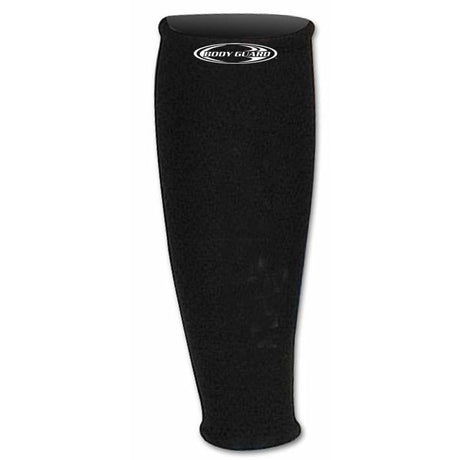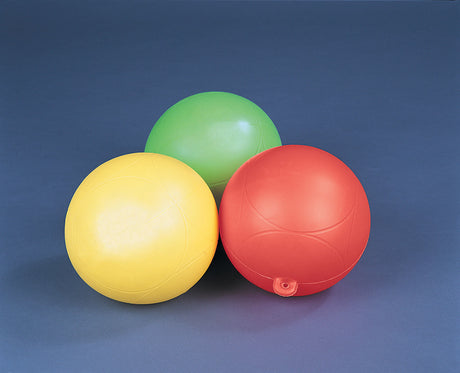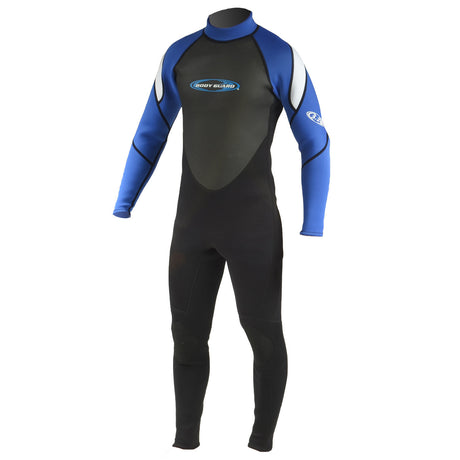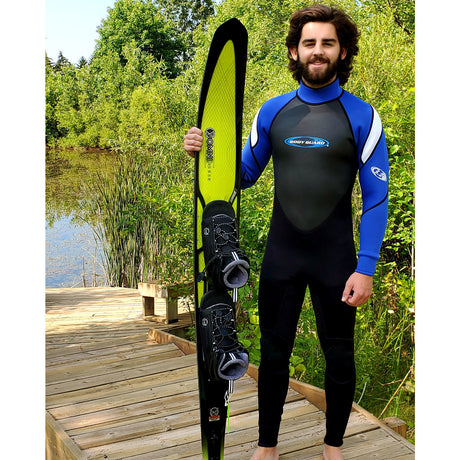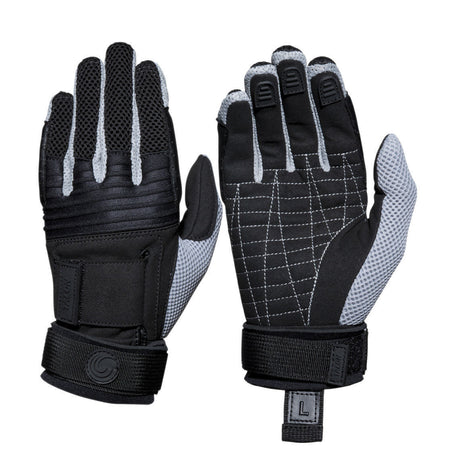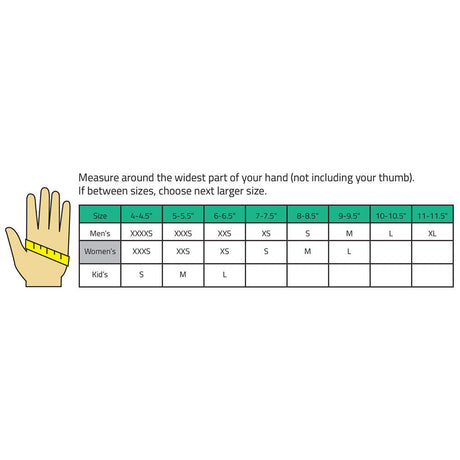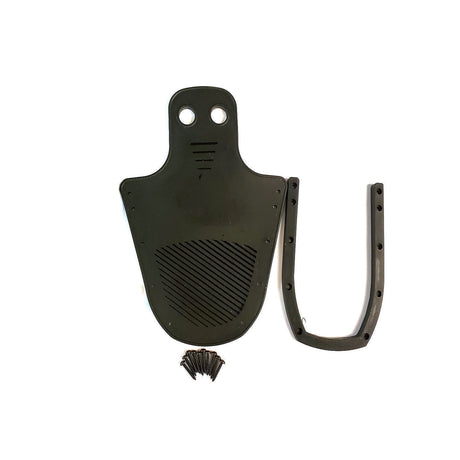Selecting the right wakeboard is crucial for an enjoyable and safe riding experience. If you're a beginner rider, you're probably wondering what wakeboard size and shape is best for you.
Here's how to pick the right size board based on your height and weight. We're also covering board shapes, materials, edges, and other features that contribute to particular riding styles.
Wakeboard Length vs. Rider Weight

Pictured: O'Brien System Wakeboard (53")
Board length is easy: The bigger the rider, the bigger the board. Follow these guidelines to pick the right board length based on rider weight. These recommendations apply to children, men, and women.
Wakeboard Size Chart
| Rider Weight (lbs) | Board Length (cm) |
| 25 - 70 |
111 - 118 |
| 40 - 85 | 118 - 130 |
| 65 - 110 | 124 - 134 |
| 70 - 130 | 130 - 138 |
| 100 - 170 | 134 - 142 |
| 150 - 225 | 138 - 146 |
| 170 - 250 | 142 - 146 |
| 200 - 275+ | 146+ |
"Which length should I choose? Shorter or longer?"
In the size chart above, you'll notice some overlap between rider weights and board lengths. For example, we recommend a 130-lb. rider choose a board measuring 134 to 142cm or one measuring 130 to 138cm.
New Rider? Pick the Longer Board
If you're a beginner, choose a longer board. Longer wakeboards are more forgiving. Their larger surface areas require less energy to stay atop the water, which provides an easier and more enjoyable learning experience for new riders.
Why Choose a Shorter Wakeboard?
Shorter wakeboards have less surface area, so they require more energy to stay atop the water -- a challenge any new rider might not like. But shorter boards also provides plenty of advantages:
Maneuverability
Shorter boards have less surface area, which makes them more agile and responsive. They provide quicker transitions, easier spins, and sharper turns.
Increased Control
Less surface area means less resistance and greater edge control and edge-to-edge transition. This extra control is essential for riders who want to perform tricks and maximize jumps.
Reduced Swing Weight
Shorter boards typically have less swing weight, making them easier to maneuver in the air. Riders who perform aerial tricks and spins often prefer shorter boards because they can spin faster and with less effort.
Park Riding
Shorter wakeboards are often favored for wake park riding, where riders navigate obstacles like ramps, rails, and kickers. The reduced length allows for better control when hitting features in the park.
The extra agility and control afford by a shorter board is favored by more experienced riders.
Picking a Wakeboard Shape

Pictured: O'Brien System / Slingshot Nomad
When it comes to picking the perfect wakeboard, shape matters as much as length. There are three key components that make up your board's ideal shape: Board width, board shape, and rocker profile.
Rocker profiles contribute most to performance. Let's look at those first.
Wakeboard Rocker Profiles

The rocker profile determines the shape of a wakeboard along its length. There are four typical rocker profiles, each made for a specific riding style.
Continuous Rocker

Designed for a smooth, predictable ride.
The continuous rocker sports one long, swooping profile from tail to tip. This single curve glides over the water with little resistance, allowing riders to maintain speed with little effort.
This smooth profile leaves the wake on a flat trajectory, transitioning into a flat glide with no pops.You'll enjoy a predictable ride that affords consistent carving with this rocker profile, making it a great choice for beginners.
Three-Stage Rocker
Made for tricks, pops, and aggressive riding.
The 3-stage rocker profile is made with a flat center section beneath the bindings, while the transitions from the center to the tail and tip sport acute angles or steep curves.
This profile promotes popping on and off the wake, making it easier to jump, spin, and perform tricks. But the 3-stage also creates more friction and enjoys less speed in the flats. An experienced rider with good control, and who favors an aggressive riding style, will benefit most from this profile.
Hybrid Rocker

The smoothness of a continuous profile, with the pop of a 3-stage.
The Hybrid rocker provides the best of the other two profiles: It's made with long, swooping tail and tip curves and a narrower flat center.
This hybrid setup provide the smoothness, easy carving, and consistency of a continuous rocker on the wake and in the flats, without sacrificing the pop and aggressive riding capability of a 3-stage.
Camber Rocker

Shifts weight from back to front foot, promoting more even weight distribution.
The concept of camber's been around various boardsports for decades, but it's relatively new to wakeboarding. The other rocker profiles we described all tend to promote a back foot heavy riding stance.
Introducing camber to a wakeboard promotes a "forward foot" riding stance, with more even weight distribution. Cambered wakeboards are excellent for popping off the wake, performing big jumps, and wake-to-wake riding.
Riders who've adopted cambered boards describe their landings as incredibly soft and stable. Although camber sacrifices speed, it promotes excellent edge feel and control, while also affording greater comfort and balance.
Wakeboard Tip & Tail Shapes

The tip and tail shape of a wakeboard influences how it handles on jumps and landings. There are four main tip and tail shapes found on modern boards: Round, square, diamond, and swallow. Most boards blend these shapes to achieve a particular ride quality or feel.
Diamond and swallow tips and tails, like the O'Brien Valhalla (left), and the Liquid Force Remedy (second from right), both provide a more forgiving ride with high responsiveness. The diamond tip produces less pop with soft landings, while the swallow tip produces a bit more pop with harder landings.
Round and square tips and tails, like the Ronix Parks (second from left), and the Hyperlite Capitol (right), both provide better pop than the diamond and swallow shapes, thanks to their extra surface area and singular edges. Square tips are more reactive, and are made for aggressive riding, while round tips produce a smoother ride style without sacrificing airtime.
Other Wakeboard Features

Many boards have additional features designed to further improve handling, speed, and stability. Other features make it easier to jump and perform tricks.
Concave Cut-Outs
These inverted cut-outs promote lift while you ride atop the water, improving stability and reducing the energy required to maintain speed.
Channels
Channels are long, smooth ridges molded into the underside of a board, along its length. They help break surface tension as you hit the water after a jump, softening the landing.
V-Shape Spines
Spines act like larger channels. They help soften the landing from a jump, too. But they also make it easier to roll your board from edge to edge, making carving easier. You'll often find these spines on 3-stage rocker boards, which tend to have harsher landings because of their flat center sections.
Fins
Fins dramatically improve control while changing direction and carving. Small fins are great for reducing that "float-y" feeling you may feel while surfing. Larger fins are great for beginners because they provide high stability while also marginally affecting speed via friction.
Read our in-depth guide to wakeboard / wakesurf fins!
Featureless
Featureless boards have slick bottoms -- no fins, spines, nor channels. They're best for quick turns, spins, and park riding, where fast reaction times are needed. A featureless board's control is solely dependent on its rocker profile and edges.
Grind Base
Some boards feature reinforced center sections designed to allow rail riding without risking damaging or cracking the board. Grind bases allow riders to ride over obstacles safely.
Now that you're familiar with all the qualities that make a wakeboard, check out our quality selection of boards!



